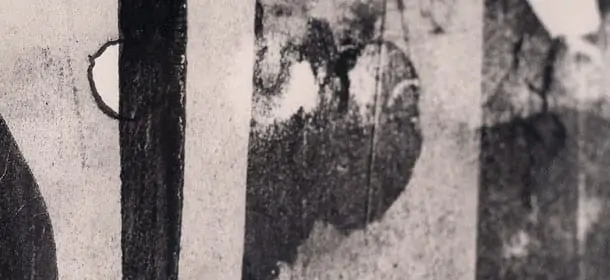

Katherine Rand, one of three first-time award winners in the January All-Media Exhibit, juried by Paul Reuther, told us how gelatin monoprinting works and about finding inspiration in the figure and art history in this Q&A:

What was your goal with Danger Lurks? Did you have any particular inspiration for the figures and the composition?
Katherine Rand: When I created Danger Lurks I was starting on another series of prints that featured ballroom dancers. I was toying with the idea of incorporating other figures in with the dancers. I thought that perhaps the audience or an announcer might add something to the composition.
This brought to mind some of Toulouse-Lautrec’s famous posters. One in particular, Moulin Rouge: La Goulue, intrigued me. In the background is the silhouette of an audience, in the middle ground is the featured dancer and in the foreground is the shadowy figure of another dancer. This gave me a place to start.
I cut out some rough templates for background, middle ground and foreground figures, intending to use these to plan the layout for some of my ballroom prints. As sometimes happens, things did not go as planned. As I worked with these stand-in figures a new story line began to emerge on my gelatin printing plate. The middle ground dancer became a little girl next to the shadowy foreground figure and the background audience dropped out of the picture. Apparently my cast of characters was not interested in putting on a dance performance that day.
I did go on to create some ballroom dancer prints, without other figures. The dancers were happy to be the only featured characters. The Moulin Rouge-inspired characters live on only in this one piece, Danger Lurks.

For people unfamiliar with the technique, can you explain how a gelatin monoprint is made?
Creating gelatin monoprints begins with making a thin sheet of gelatin to use as the inking surface. Once it has hardened, printing ink is rolled onto the gelatin plate. I use mostly Speedball water-soluble Block Printing Ink for this.
At this point, different effects can be achieved by removing ink from the gelatin in some areas and masking it in others. A piece of printmaking paper is laid face-down on the inked surface to produce the print. The soft, slightly damp surface of the gelatin releases the ink without the use of a press.

Why are you a printmaker? What is the appeal of monoprinting, specifically?
Printmaking has seemed a natural extension of the drawing I do. For the last seven years I have I have run the life drawing program for the Del Ray Artisans in Alexandria. My figurative prints have developed out of the figure drawing I do from our models there. I enjoy the one-of-a-kind approach of monoprinting because there is always something new to discover and learn with each print.

What are you working on now?
Lately I have been doing a fair number of trace monotypes. This technique involves inking a Plexiglas plate, placing a piece of paper face-down on top of the ink and drawing on the back of the paper to transfer the ink. I often add some other elements to these trace monotypes using the gelatin plate. I usually use drawings I have done from life as reference for the prints I create. However, I recently did some these monotypes directly from our live models, which was a fun challenge.
Come see the January All-Media Exhibit through Monday, February 2!
Sign up for our weekly blog newsletter, subscribe to our RSS feed, or like us on Facebook for the latest Art League news. Visit our homepage for more information about our classes, exhibits, and events in Old Town Alexandria, Virginia.
You can support The Art League every time you shop through AmazonSmile!
Simply set The Art League as your chosen charity, and every time you shop at smile.amazon.com, a portion of your purchase will be donated to support our mission to share the experience of visual arts with the community.